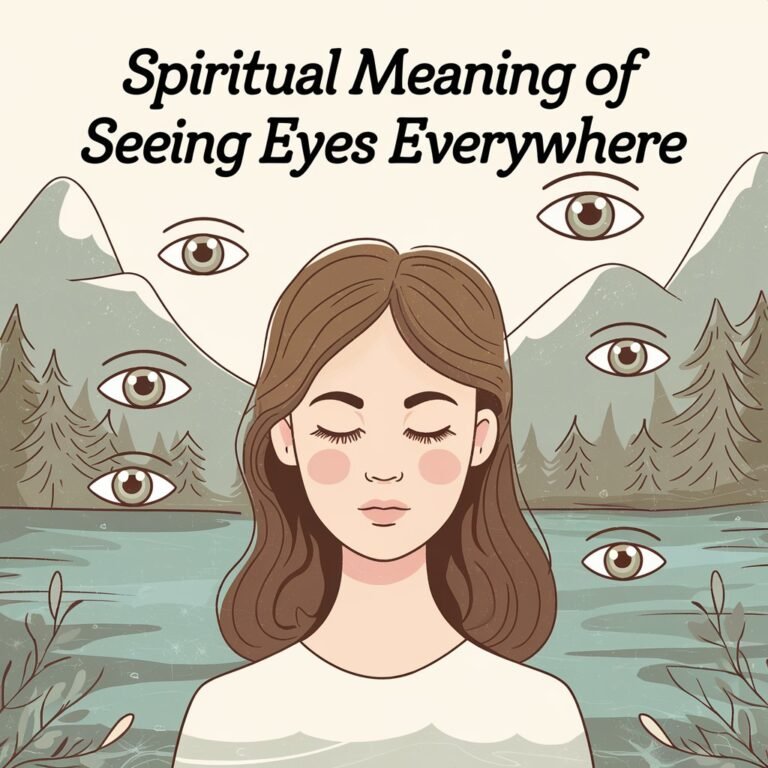Spiritual Meanings of Balance: 12 Mystical Symbolism
Balancing forces shape much of our spiritual landscape, revealing truths across cultures and philosophies. From the scales of justice to celestial and natural symbols, each represents more than its surface — embodying harmony, justice, or cyclical renewal. Understanding these symbols can deepen your appreciation for inner stability amid life’s oscillations. As you explore the interconnectedness behind each sign, consider how they reflect a universal pursuit of equilibrium that influences your own path toward harmony and purpose.
The Scales of Libra
The Scales of Libra stand for balance and fairness. Many cultures see them as a symbol of justice. They remind us to look at our actions and decide if they’re right.
The scales show that being fair helps us stay happy and peaceful. They teach us that we need to be honest and kind both inside and outside.
Across different places and times, people have used the scales to show that fairness makes communities strong. When we try to be fair, we feel connected to others.
The scales encourage us to always look for what’s right and to act with integrity. This helps us grow and makes the world a better place.
The Ying-Yang Symbol
The Ying-Yang symbol shows how balance is important in life. It represents two opposite forces that work together. For example, light and dark, activity and rest. These opposites create harmony when they’re in sync.
When you meditate, you connect with this feeling of balance. You learn that both good and bad times are part of life. The Ying-Yang reminds us that balance isn’t fixed. It changes all the time. It needs your awareness and acceptance.
Different cultures use the Ying-Yang to explain how everything fits together. It tells us that true peace comes from embracing differences. The symbol encourages us to see balance as an ongoing process. This journey helps us grow and find inner calm.
The Mandala of Harmony
The Mandala of Harmony is a simple circle design that shows how all parts of life connect. Its details help you slow down and relax.
Many cultures, like Tibetan Buddhism, Native American tribes, and Hindu traditions, use mandalas. They help people find balance inside and feel more connected to the universe.
To use the Mandala of Harmony, look at the center and imagine your mind growing outward. This helps you feel calm and balanced.
It reminds you that good feelings and peace are always changing, not fixed. The mandala is a special symbol. It can guide you to feel peaceful and connected every day.
The Ouroboros
Have you ever thought about what it means to have constant renewal? Many cultures use a special symbol called the Ouroboros to show this idea.
The Ouroboros is a picture of a snake or dragon biting its own tail. This symbol shows how life goes in circles. It stands for life, death, and starting fresh again. It’s a reminder that change is always happening.
Different cultures, like Egyptian, Greek, and Hindu, use the Ouroboros to show how everything is connected. It reminds us that renewal happens everywhere and for everyone.
Seeing this symbol can help us feel part of something bigger. It can also help us accept change as a natural part of life. The Ouroboros encourages us to find balance even when things keep changing.
It tells us that renewal is a key part of growing and staying strong in our spiritual journey.
The Balance Beam in Ancient Egypt
In ancient Egypt, balance was very important. It wasn’t just a special symbol, but also a part of their everyday life. The Egyptians used a simple tool called a balance beam. They used it in their temples and during their daily routines.
The balance beam showed how everything should be in harmony. It was a reminder that life and death need fairness. When they judged a person’s soul after death, they used the beam to weigh the heart. If the heart was light, the soul could move on. If not, the soul faced punishment.
This idea of balance was common in many stories around the world. Other cultures also used weighing or balancing to show fairness and justice.
For the Egyptians, the balance beam was more than a scale. It stood for order, morality, and truth.
The Torus in Sacred Geometry
The torus is a shape that looks like a donut. It has a round ring with a hole in the middle. Many cultures see the torus as very special in sacred geometry. It shows how energy moves and flows in circles.
This shape reminds us that all life is connected. It shows how forces in nature stay balanced by expanding and contracting. The torus helps us understand that everything is part of a bigger system.
When we see this shape, we can feel linked to the universe. It tells us that balance is important. We need to stay in tune with natural rhythms to keep life going smoothly.
The Vesica Piscis
The Vesica Piscis is a simple yet powerful shape. It looks like an almond or an eye made from two circles that overlap. This shape shows how two things can come together and create something new.
Many spiritual traditions see it as a symbol of balance and connection. It represents opposite forces, like masculine and feminine or heaven and earth, joining as one. The shape reminds us that harmony comes from bringing different things into unity.
Its precise form shows how everything in the universe is connected. The Vesica Piscis teaches us that true peace and growth happen when we find balance in ourselves and the world around us.
The Yin-Yang Dragon
The Yin-Yang Dragon shows a strong idea of balance. The dragon is a symbol of strength and change. It mixes with the Yin-Yang symbol, which stands for duality or two opposite sides.
This shows that different kinds of energy, like chaos and order, can exist together happily. The dragon helps us see that harmony comes from mixing different parts.
In Chinese culture, the dragon means wisdom and protection. It balances the forces of the universe.
In other cultures, dragons stand for power and renewal. The Yin-Yang Dragon teaches us that true balance means accepting differences.
It reminds us that harmony is possible when we understand and accept opposites.
The Tree of Life
The Tree of Life is a symbol that shows how all living things are connected. People from different cultures, like Norse, Kabbalistic, and Indigenous groups, use this symbol. It represents the cycle of life, growth, and renewal.
When you think about the Tree of Life, it encourages you to grow spiritually. Its roots stand for strength and connection to the past, while its branches point upward, showing how you can grow and reach for more. The branches also represent different paths you can take.
The roots remind you of your ancestors and traditions. Understanding this helps you see how you fit into the bigger picture of life.
It inspires kindness and balance in your life. The Tree of Life teaches us that our spiritual journey is part of a big, connected web of life.
The Lotus Flower in Bloom
The lotus flower blooming is a strong symbol of growth and purity. It comes out of muddy waters, showing that you can stay true to yourself even during tough times.
When the lotus opens into a beautiful flower, it reflects your own journey of becoming stronger and wiser. In many cultures, the lotus stands for purity, harmony, and new beginnings.
It reminds us that everyone can grow and find peace inside. Whether you practice meditation or simply want to be more centered, thinking of the lotus can help you feel calmer and more connected.
It shows that with patience and effort, you can overcome difficulties and shine brightly.
The Chimera of Duality
The chimera of duality shows how opposite forces exist inside us. It helps us understand that we can have both light and dark sides. Things like chaos and order are part of who we are.
Seeing these differences helps us grow spiritually. It’s important to accept all parts of ourselves, even those we don’t like.
Many cultures and religions talk about this idea. They say that embracing both sides creates balance and makes us feel connected to something bigger.
The chimera reminds us that growth comes from handling contradictions. When we do this, we learn more about ourselves and our spirit.
Working through these dualities helps us become whole and true to ourselves.
The Celestial Equator
Have you ever looked up at the sky and wondered what the stars and planets can tell us? One special line in the sky is called the celestial equator. It’s an imaginary line that divides the sky into two equal parts.
This line can teach us about balance, harmony, and how everything in the universe is connected.
The celestial equator is similar to a balance point. It shows how different parts of the universe stay in harmony and stay connected. Many cultures see this line as a symbol of balance between the spiritual world and everyday life.
When you understand this, you realize how important it’s to find a balance inside yourself and in your surroundings.
Across many traditions, the celestial equator helps remind us that everything in the universe works together in a rhythm. When we keep our inner energies balanced and stay connected to what’s around us, we can grow spiritually and feel more at peace.
Seeing the sky this way can help you feel like you’re part of a bigger, beautiful pattern.
In summary, the celestial equator is more than just a line in the sky. It’s a symbol of harmony and unity.
Looking at it can help you understand how you fit into the universe’s big, balanced design. It encourages you to find balance in your life and stay connected to the world around you.
Frequently Asked Questions
How Do Different Cultures Interpret the Symbolism of Balance?
The current question explores how different cultures interpret balance through cross-cultural symbolism and historical interpretations. You see that in every society, balance signifies harmony, stability, and interconnectedness, reflecting shared human values across diverse traditions and beliefs.
What Are Common Misconceptions About Spiritual Balance Symbols?
You might believe that spiritual balance symbols universally symbolize harmony, but misinterpretation myths exist; modern misconceptions often overlook cultural contexts, leading to erroneous assumptions about their meanings and significance in fostering a shared sense of belonging.
Can These Symbols Represent Personal Growth Beyond Spiritual Realms?
You see, these symbols can indeed represent personal growth beyond spiritual domains, fostering emotional stability and development across cultures. They symbolize belonging and resilience, encouraging you to seek balance as a universal foundation for meaningful, cross-cultural personal progress.
How Do These Symbols Influence Mindfulness and Meditation Practices?
These symbols guide your mindfulness and meditation by promoting chakra harmony and energy alignment, fostering a sense of belonging across cultures. They connect you to universal spiritual truths, enhancing personal growth through deep, contextual understanding of energy flow.
Are There Historical Origins Behind the Popular Mystical Symbols of Balance?
You’ll find that mystical symbols of balance stem from ancient talismans and mythical references, crossing cultures. These origins reveal how societies sought harmony, fostering a sense of belonging through shared understanding of universal themes and ancient spiritual wisdom.

Sofia Phillips is a renowned spirituality expert and the visionary behind SoulfulCreature.com. With a compassionate heart and an enlightened mind, Sofia embarks on a quest to guide others through the realms of spirituality. Her approach is deeply rooted in providing a nurturing and positive experience, allowing individuals to explore and grow in their spiritual journey.







